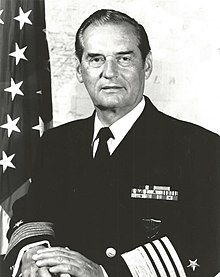Charles K. Duncan
| Charles K. Duncan | |
|---|---|

As SACLANT/CINCLANT/CINCLANTFLT, c. 1970s
|
|
| Born |
December 7, 1911 Nicholasville, Kentucky |
| Died | June 27, 1994 (aged 82) La Jolla, California |
| Allegiance |
|
| Service/branch |
|
| Years of service | 1933–1972 |
| Rank |
|
| Commands held | Atlantic Command U.S. Atlantic Fleet Second Fleet U.S. Naval Base Subic Bay Amphibious Training Command USS Wilson (DD-408) |
| Battles/wars |
World War II Cold War |
| Awards |
Distinguished Service Medal Legion of Merit |
| Other work | Board of Trustees, San Diego Museum of Art |
Charles Kenney Duncan (December 7, 1911–June 27, 1994) was a United States Navy four star admiral who served as Supreme Allied Commander Atlantic/Commander in Chief, United States Atlantic Command/Commander in Chief, U.S. Atlantic Fleet (SACLANT/CINCLANT/CINCLANTFLT) from 1970 to 1972.
Duncan was born on December 7, 1911 in Nicholasville, Kentucky. At the age of nine his mother became a full professor at the University of Kentucky, and the family moved to Lexington, where he attended University High School, Kavanaugh Preparatory School, and the University of Kentucky before entering the United States Naval Academy. Graduating in 1933, he was commissioned an Ensign and was assigned to the USS Salt Lake City (CA-25), where he remained for five years. Transferring to the Atlantic in 1938, he served aboard the USS Schenck (DD-159), and in June 1940 was assigned to the staff of Commander Destroyers, Atlantic Fleet, at the time of that command's creation. During his tenure he met Sheila Taylor of Halifax, Nova Scotia, whom he married in the summer of 1941 in Bermuda.
In 1942 he was the first executive officer of the destroyer USS Hutchins (DD-476), which proceeded from the Atlantic to the Pacific, taking part in combat in the Aleutians and the South Pacific. He was given command of the USS Wilson (DD-408), seeing combat in the South and Central Pacific areas. During this time he was awarded two Navy Commendation medals with Combat "V." Towards the end of the war he was assigned as Director of Naval Officer Procurement, Bureau of Naval Personnel, a position he held from 1944 to 1946.
Following World War II, he served in various capacities such as Executive Assistant to the Chief of Naval Personnel 1953 to 1955, a battleship executive officer, commanding an amphibious ship and a destroyer division, and as operations officer of the U.S. Pacific Fleet. He also served on the Holloway Board whose mission was to "study the form, system, and method of education of Naval officers." The outcome of the board was the establishment of modern Naval ROTC and direct commissions for college graduates from Officer Candidate School.
...
Wikipedia
